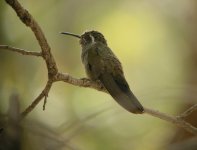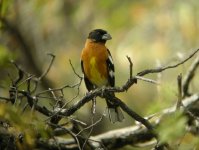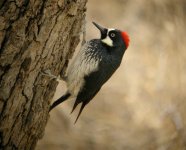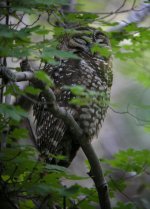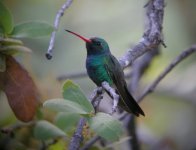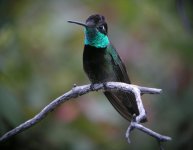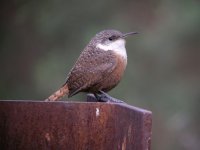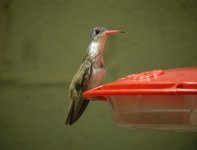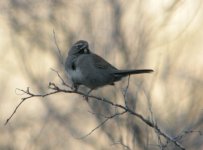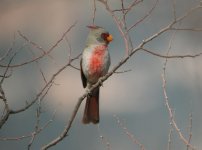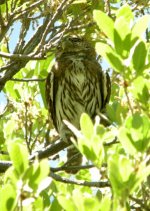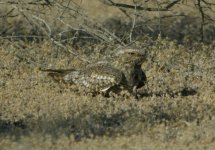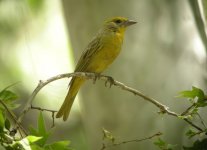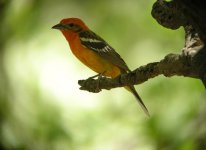Mark Harper
World Birder
May 1st 2009
Arrived in Phoenix just after 5pm, by the time we had cleared immigration, collected our bags and hire car it was 7pm and we had a two hour plus drive to Tucson to look forward to. Fortunately the traffic wasn’t too heavy and we made it to our Motel shortly after 9pm having seen a few Great-tailed Grackles and a lone Lesser Nighthawk along the way.
May 2nd 2009
An early start was not a problem as the time difference resulted in us being wide awake very early, by 6.30am we had made our way east to Wilcox where we refuelled the car and ourselves and saw our first Western Kingbirds, Curve-billed Thrasher and Bullocks Oriole in the Safeway car park.
Up until this point all our driving had been on freeways and hence the opportunity for stopping had been limited, so as soon as we could we found a side road to pull onto and have ten minutes birding in the dry desert scrub. There was not much to see, but an immature Black-throated Sparrow had us scratching our heads until an adult appeared next to it.
Pinery Canyon was our destination and we passed several occupied camping areas before we found somewhere vacant to park and explore. A Black-headed Grosbeak was soon found singing and this proved to be one of the most common birds in southeast Arizona, present at most locations visited. The first lifer of the trip was also one of the best a fabulous Painted Redstart, which flitted about just above head height whilst occasionally singing.
One of only two Olive-sided Flycatchers noted during the trip was singing from a dead snag and a Buff-breasted Flycatcher was also heard and quickly responded to playback. A female Hummingbird kept zipping past, but it wasn’t until she landed on her nest, which was festooned with lichen in a pine tree, that we were able to identify her as a Black-chinned Hummingbird. Back near the car we came across a Yellow-eyed Junco, which we found to be common throughout the trip at high altitudes.
One of the main reasons for coming to this corner of southeast Arizona is to see Mexican Chickadee, as all the other species on offer can be seen elsewhere, so we pushed on up to Pinery Canyon Campground, which is supposedly good for this specie. Prior to travelling to Arizona I had been keeping track of various reports from the area and whilst one recent report said they were common another had failed to find them at all.
Fortunately for us the Campground was empty and the wind on this side of the peak was insignificant, when we went over the top later on the wind was really gusting. Within a few minutes of arriving we heard the first Mexican Chickadee and it did not take too long to track down. Shortly afterwards we actually found a nest hole, that was being regularly visited, in total there were probably at least four birds in the campground. However, when we later pointed some other birders to this site they spent an hour there without any sign of a Chickadee, fortunately they picked one up nearby later.
Another star bird of the “sky islands”, the mountains of southeast Arizona, is the Red-faced Warbler and we were not to be disappointed when we saw our first in the pine trees around the campground. There were also one or two Grace’s Warblers in the area, but these seemed to stay higher in the trees so the views were mostly of their underside. The real warbler event though was an enormous flock of Townsends Warblers, with a few Hermit Warblers thrown in for good measure, we literally saw several hundred passing through the campground. Later on the Arizona Listserv we read a report of in excess of a thousand birds passing a point on the same mountain. A Bridled Titmouse in the same area, reminded us of the Crested Tits we get back in Europe.
Once we crossed the pass the wind picked up considerably and we struggled to add much to our list, but our first Mexican Jay’s were much appreciated. Much lower down we spent sometime looking for Black-chinned Sparrows along the road between Paradise and Portal, but without any success.
At Portal we checked into our accommodation and went for a stroll around the town, more like a small village, to see what was visiting the various feeders. The feeders next to the Portal Store were dominated by Pine Siskins with a few Lesser Goldfinches, but those by the post office had a greater diversity. Acorn Woodpeckers, Lazuli Buntings, Chipping Sparrows fed side by side with a cracking male Summer Tanager. Whilst across the road a Wilson’s Warbler crept through the bushes, a Lincoln’s Sparrow fed in the stream and a Brown-crested Flycatcher called loudly.
With the exception of Cape May, most other places I have visited in the USA there have been very few birders, this is definitely not the case in southeast Arizona in May when birdwatchers are everywhere. Walking back to the store we met a couple of birders that were camping in Cave Creek and they invited us along to see their feeders, so off we went. Most of the species we had already seen, but a Blue-throated Hummingbird was new, unfortunately it was also very dominant so any other hummingbirds that got close were chased off before we could even pick up our binoculars.
After about an hour we bade our farewells and headed to bird the road along the south fork of Cave Creek. Late afternoon in southeast Arizona seemed to be fairly quiet wherever we went and here was no exception, but we did manage to pick up an Arizona Woodpecker, a Hammond’s Flycatcher and a Hermit Thrush, before heading back to Portal for some dinner.
Arizona has a lot of nightbirds so we headed out armed with a spotlight to see what we could see. Before it got dark we headed towards Paradise, failing to find Black-chinned Sparrows again. As darkness fell we headed back towards Portal stopping to listen for Common Poorwills, partway back we came across a large tour group positioned where Common Poorwills were singing from high up the slopes, rather than stopping as they did not appear to be looking at anything we decided to try and find our own. 100 metres down the road they had parked there two minbuses and sat on the road right next to them was a Common Poorwill, which we watched in our headlights for a short time.
Heading to the south fork of Cave Creek we heard a Whiskered Screech-Owl singing across the road from the entrance to Idlewood campground. After a short time stumbling about in the dark we were able to spotlight one bird whilst another sang close by and also flew through the spotlight beam. With a hectic following day planned we decided to call it a night and headed back to Portal, very satisfied with our first days sightings.
Arrived in Phoenix just after 5pm, by the time we had cleared immigration, collected our bags and hire car it was 7pm and we had a two hour plus drive to Tucson to look forward to. Fortunately the traffic wasn’t too heavy and we made it to our Motel shortly after 9pm having seen a few Great-tailed Grackles and a lone Lesser Nighthawk along the way.
May 2nd 2009
An early start was not a problem as the time difference resulted in us being wide awake very early, by 6.30am we had made our way east to Wilcox where we refuelled the car and ourselves and saw our first Western Kingbirds, Curve-billed Thrasher and Bullocks Oriole in the Safeway car park.
Up until this point all our driving had been on freeways and hence the opportunity for stopping had been limited, so as soon as we could we found a side road to pull onto and have ten minutes birding in the dry desert scrub. There was not much to see, but an immature Black-throated Sparrow had us scratching our heads until an adult appeared next to it.
Pinery Canyon was our destination and we passed several occupied camping areas before we found somewhere vacant to park and explore. A Black-headed Grosbeak was soon found singing and this proved to be one of the most common birds in southeast Arizona, present at most locations visited. The first lifer of the trip was also one of the best a fabulous Painted Redstart, which flitted about just above head height whilst occasionally singing.
One of only two Olive-sided Flycatchers noted during the trip was singing from a dead snag and a Buff-breasted Flycatcher was also heard and quickly responded to playback. A female Hummingbird kept zipping past, but it wasn’t until she landed on her nest, which was festooned with lichen in a pine tree, that we were able to identify her as a Black-chinned Hummingbird. Back near the car we came across a Yellow-eyed Junco, which we found to be common throughout the trip at high altitudes.
One of the main reasons for coming to this corner of southeast Arizona is to see Mexican Chickadee, as all the other species on offer can be seen elsewhere, so we pushed on up to Pinery Canyon Campground, which is supposedly good for this specie. Prior to travelling to Arizona I had been keeping track of various reports from the area and whilst one recent report said they were common another had failed to find them at all.
Fortunately for us the Campground was empty and the wind on this side of the peak was insignificant, when we went over the top later on the wind was really gusting. Within a few minutes of arriving we heard the first Mexican Chickadee and it did not take too long to track down. Shortly afterwards we actually found a nest hole, that was being regularly visited, in total there were probably at least four birds in the campground. However, when we later pointed some other birders to this site they spent an hour there without any sign of a Chickadee, fortunately they picked one up nearby later.
Another star bird of the “sky islands”, the mountains of southeast Arizona, is the Red-faced Warbler and we were not to be disappointed when we saw our first in the pine trees around the campground. There were also one or two Grace’s Warblers in the area, but these seemed to stay higher in the trees so the views were mostly of their underside. The real warbler event though was an enormous flock of Townsends Warblers, with a few Hermit Warblers thrown in for good measure, we literally saw several hundred passing through the campground. Later on the Arizona Listserv we read a report of in excess of a thousand birds passing a point on the same mountain. A Bridled Titmouse in the same area, reminded us of the Crested Tits we get back in Europe.
Once we crossed the pass the wind picked up considerably and we struggled to add much to our list, but our first Mexican Jay’s were much appreciated. Much lower down we spent sometime looking for Black-chinned Sparrows along the road between Paradise and Portal, but without any success.
At Portal we checked into our accommodation and went for a stroll around the town, more like a small village, to see what was visiting the various feeders. The feeders next to the Portal Store were dominated by Pine Siskins with a few Lesser Goldfinches, but those by the post office had a greater diversity. Acorn Woodpeckers, Lazuli Buntings, Chipping Sparrows fed side by side with a cracking male Summer Tanager. Whilst across the road a Wilson’s Warbler crept through the bushes, a Lincoln’s Sparrow fed in the stream and a Brown-crested Flycatcher called loudly.
With the exception of Cape May, most other places I have visited in the USA there have been very few birders, this is definitely not the case in southeast Arizona in May when birdwatchers are everywhere. Walking back to the store we met a couple of birders that were camping in Cave Creek and they invited us along to see their feeders, so off we went. Most of the species we had already seen, but a Blue-throated Hummingbird was new, unfortunately it was also very dominant so any other hummingbirds that got close were chased off before we could even pick up our binoculars.
After about an hour we bade our farewells and headed to bird the road along the south fork of Cave Creek. Late afternoon in southeast Arizona seemed to be fairly quiet wherever we went and here was no exception, but we did manage to pick up an Arizona Woodpecker, a Hammond’s Flycatcher and a Hermit Thrush, before heading back to Portal for some dinner.
Arizona has a lot of nightbirds so we headed out armed with a spotlight to see what we could see. Before it got dark we headed towards Paradise, failing to find Black-chinned Sparrows again. As darkness fell we headed back towards Portal stopping to listen for Common Poorwills, partway back we came across a large tour group positioned where Common Poorwills were singing from high up the slopes, rather than stopping as they did not appear to be looking at anything we decided to try and find our own. 100 metres down the road they had parked there two minbuses and sat on the road right next to them was a Common Poorwill, which we watched in our headlights for a short time.
Heading to the south fork of Cave Creek we heard a Whiskered Screech-Owl singing across the road from the entrance to Idlewood campground. After a short time stumbling about in the dark we were able to spotlight one bird whilst another sang close by and also flew through the spotlight beam. With a hectic following day planned we decided to call it a night and headed back to Portal, very satisfied with our first days sightings.




